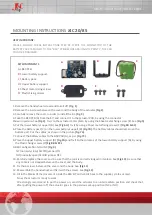
Hardware
13
SLAU678A – March 2016 – Revised April 2016
Copyright © 2016, Texas Instruments Incorporated
MSP430FR5994 LaunchPad™ Development Kit (MSP
‑
EXP430FR5994)
Figure 9. MSP-EXP430FR5994 Super Cap Power Block Diagram
2.3.3
Super Cap (C1)
A 220-mF (0.22-F) super cap is mounted onboard and allows powering the system without any external
power. This demonstrates the ultra-low power of the MSP430FR5994 target MCU. See how long you can
run your application on the super cap alone!
2.3.3.1
Charging the Super Cap
The super cap can be charged when the EVM is plugged into the PC or when the board is externally
powered. During charging, set J8 to the Charge setting, which adds a current limiting resistor for charging.
To charge the super cap, power must be coming from the eZ-FET debug probe, external power through
J5, or a BoosterPack plug-in module powering through J1. Allow two to three minutes for the super cap to
charge (time may vary depending on initial charge of the super cap and the power source) to full V
CC
.
2.3.3.2
Using the Super Cap
After charging of the super cap, move the J8 jumper to the Use setting and unplug power. This connects
the super cap to the 3V3 rail without the charging resistor. Now, the LaunchPad development kit is being
powered completely by the C1 super capacitor.
For the lowest-power operation, make sure to disconnect the J101 jumpers and remove the microSD card
if it is not in use. Removing J101 jumpers prevents the super cap from powering the eZ-FET circuitry and
consuming additional power. The microSD card has approximately 100 µA of current draw just being
plugged into the system, even when not in use. Taking these steps allows your application to be powered
longer from only the super cap.














































